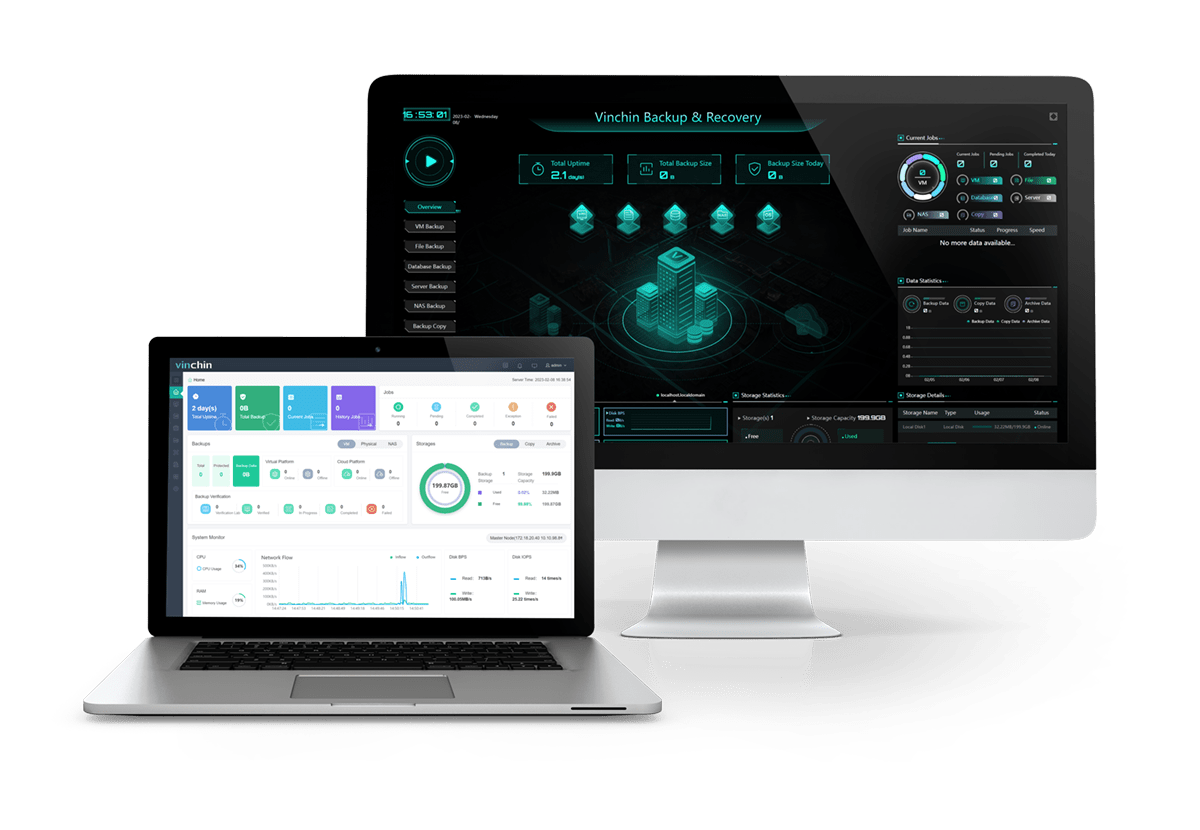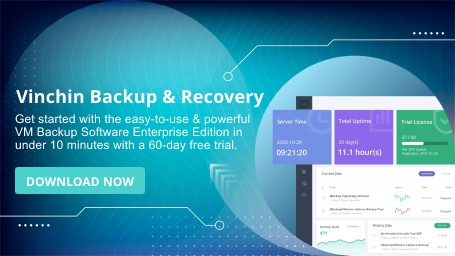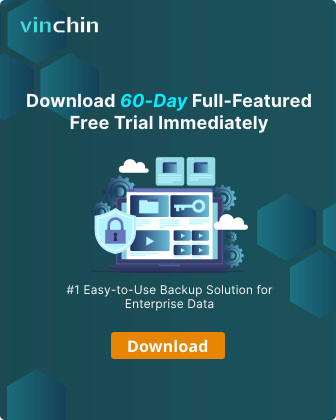-
Prepare for data center migration
-
Make a detailed data center migration plan
-
Data center migration steps
-
Make a detailed data center migration plan
-
Data center migration steps
-
VM backup and migration with Vinchin Backup & Recovery
-
Conclusion
Change is inevitable. Organizations are taking transformational steps that require the efficient transfer of large amounts of data in a given amount of time. These specific changes involve mergers, new hires, or program acquisitions requiring speed, flexibility, and superior performance. Regardless of the size, data migrations must minimize disruption to day-to-day operations.
To ensure this, you need to plan your data center migration carefully. By redesigning the traditional data center, companies can correct their deficiencies and provide better services accordingly. As your company grows and develops, minimizing the risk of downtime and failure to meet all business needs should be considered a top priority. With that in mind, here's a checklist of what you'll need to successfully migrate your data center.
Prepare for data center migration
As with any adventure in life, it's always best to be prepared. Having a sound plan in place allows organizations to track their progress and manage their expectations. Before a data center migration, businesses should plan for everything. They should be able to get an idea of what is involved in the move. It is best to prepare a list of all the necessary data center migration activities to get a comprehensive idea of what is required. Most businesses prioritize the IT equipment that provides the most value to the organization.
To help you make your decision, make sure you get the answers to the following questions beforehand:
● Is this application relevant to the organization's current and future projects?
● If so, what configurations come with these projects to make them run efficiently?
● How much downtime will transportation of this particular equipment result in?
● What measures have been taken to minimize operational disruptions caused by data center relocations?
It is important to note that each application and device in the data center has a different purpose and use. Therefore, it is important to label and segregate all content accordingly. After documenting all the content in the data center to be moved, you can take the next steps. You need to list all the factors that can help your organization determine the relevance of specific applications and devices in the data center. These factors include identifying the following:
● Application Owner
● Possible upgrade and change dates
● Allowable downtime
● Server, network, storage and operating system requirements
● Power supply specifications
● Connection (wiring) diagrams
● Rack Layout
In addition to the physical aspects of any data center, it's integral to evaluate other factors prior to migration. Prioritizing workforce, business objectives and risk assessment can help you speed up the migration process. To help you develop a sound data center relocation plan, be sure to consider the following:
● Is your workforce sufficient to support a data center migration?
● How does this shift impact your business goals?
● What are the risks associated with facilitating a data cent
Make a detailed data center migration plan
Having a detailed process plan is critical for data center migration. This plan allows you to prepare your strategy and backup plan throughout the process. While the methodology used depends on your company's resources and needs, the key to developing a sound plan is to fully understand your environment. Assemble a trusted team to help achieve a seamless and successful data center relocation.
Data center migration steps
Data center relocation can become overwhelming, especially if large amounts of data are involved. Organizations must be well-prepared, including moving equipment, schedules and shipping items. Consider the following practices that can help you ultimately succeed.
Start with a sensible plan
Any project will run smoothly with a sound plan. Whether you're planning to consolidate data, move devices, or ship office supplies to your new office, make sure you have everything in place beforehand. The first thing you need to do is ensure a seamless device migration. Otherwise, a single device that fails during transportation could jeopardize critical business data.
Make sure you contact reputable service providers to offer insurance options for valuable transactions. Some companies also have the resources to perform data migrations themselves. While this can be cost-effective, organizations must ensure that the movers are knowledgeable enough to handle the IT equipment. Now that you have found a reliable enabler, you should develop a comprehensive plan on how to proceed with the migration.
Depending on your preferences, needs, and budget, you can move everything at once or in batches. While it may seem practical to tackle all of your equipment immediately, the latter gives you a chance to see how your workplace rolls with limited items on hand. Moving your stock in bulk offers businesses the opportunity to minimize downtime. If you're planning to move into a new space, you can utilize this opportunity to settle existing contracts.
Create a comprehensive list
Be sure to log all equipment for inventory before making all preparations for the move. Log all mechanical components to a list before unplugging and taking them to the loading dock. Make note of active workloads, scheduled backups, and utilize software applications to avoid falling behind on essential tasks before pulling system logs. Creating a comprehensive list allows you to spot items to discard and keep. Check for items that may affect their warranty when moved to a different location. Organizations must notify their customers of the relocation that will take place. They should know where the new location is so they can determine where to go if necessary.
Building teams to facilitate data center migrations
Establish a trusted security team who can assist throughout the process. This team can increase the organization's confidence in the security of all equipment and confidential data in transit.
To keep things organized, here are some key steps and suggestions: er move and how will you mitigate them?
Make a detailed data center migration plan
Having a detailed process plan is critical for data center migration. This plan allows you to prepare your strategy and backup plan throughout the process. While the methodology used depends on your company's resources and needs, the key to developing a sound plan is to fully understand your environment. Assemble a trusted team to help achieve a seamless and successful data center relocation.
Data center migration steps
Data center relocation can become overwhelming, especially if large amounts of data are involved. Organizations must be well-prepared, including moving equipment, schedules and shipping items. Consider the following practices that can help you ultimately succeed.
Start with a sensible plan
Any project will run smoothly with a sound plan. Whether you're planning to consolidate data, move devices, or ship office supplies to your new office, make sure you have everything in place beforehand. The first thing you need to do is ensure a seamless device migration. Otherwise, a single device that fails during transportation could jeopardize critical business data.
Make sure you contact reputable service providers to offer insurance options for valuable transactions. Some companies also have the resources to perform data migrations themselves. While this can be cost-effective, organizations must ensure that the movers are knowledgeable enough to handle the IT equipment. Now that you have found a reliable enabler, you should develop a comprehensive plan on how to proceed with the migration.
Depending on your preferences, needs, and budget, you can move everything at once or in batches. While it may seem practical to tackle all of your equipment immediately, the latter gives you a chance to see how your workplace rolls with limited items on hand. Moving your stock in bulk offers businesses the opportunity to minimize downtime. If you're planning to move into a new space, you can utilize this opportunity to settle existing contracts.
Create a comprehensive list
Be sure to log all equipment for inventory before making all preparations for the move. Log all mechanical components to a list before unplugging and taking them to the loading dock. Make note of active workloads, scheduled backups, and utilize software applications to avoid falling behind on essential tasks before pulling system logs. Creating a comprehensive list allows you to spot items to discard and keep. Check for items that may affect their warranty when moved to a different location. Organizations must notify their customers of the relocation that will take place. They should know where the new location is so they can determine where to go if necessary.
Building teams to facilitate data center migrations
Establish a trusted security team who can assist throughout the process. This team can increase the organization's confidence in the security of all equipment and confidential data in transit.
To keep things organized, here are some key steps and suggestions:
● Project preparation and organization: Before proceeding with data center migration, ensure that all necessary items are organized. To keep everything organized, make sure all containers are properly labeled.
● Cable and wire management: Always make sure that cables and wires are kept close to the equipment to which they are connected. Use room labels to avoid confusion during installation, especially in large data centers that are often spread across different floors.
● Security log monitoring: Keep a close eye on security logs to monitor the data center move process and ensure that no items are compromised. It is critical to have multiple layers of security measures in place to prevent unauthorized access to data.
Key steps and reflections after a successful data center migration
After successfully migrating your data center, it is important to ensure that everything has been tested. Using your inventory as a reference, you can check all items involved in the process. Make sure everything is ready and working properly.
If everything goes well and there are no errors, you can say that the data center move was successful. Another key factor in determining the success of the project is whether it arrived on schedule. Reviewing the results of this program can help the team reflect on what went wrong and what they need to improve.
VM backup and migration with Vinchin Backup & Recovery
Data center migration is a complex process that involves many components. The process requires careful planning and coordination to ensure that business continuity and performance are not affected. While successfully completing a data center move is an important milestone, protecting and managing the VMs cannot be overlooked.
After the migration, you need to ensure that appropriate measures are in place to protect the VMs from potential security threats. It is only through a combination of post-migration security and management measures that you can ensure the stable operation of your data center and the continued success of your business.

Vinchin Backup & Recovery is a backup solution designed for virtual machines of VMware, Hyper-V, XenServer, XCP-ng, oVirt, RHV, etc. It provides comprehensive and powerful VM backup and recovery features like agentless backup, instant recovery, V2V migration designed to protect and manage critical data in the virtualization environment.
Vinchin Backup & Recovery’s operation is very simple, just a few simple steps. Just select VMs on the host > then select backup destination > select strategies > finally submit the job
Vinchin offers a free 60-day trial for users to experience the functionality in a real-world environment. For more information, please contact Vinchin directly or contact our local partners.
Conclusion
Overall, data center migration is an important step that must be taken by organizations undergoing transformational change. Adequate preparation, including detailed planning and an effective team, is critical to a successful migration. After migration, protecting and managing VMs is key to ensuring business continuity. Vinchin Backup & Recovery provides a comprehensive solution for protecting and managing VMs in virtualized environments.
Share on:







